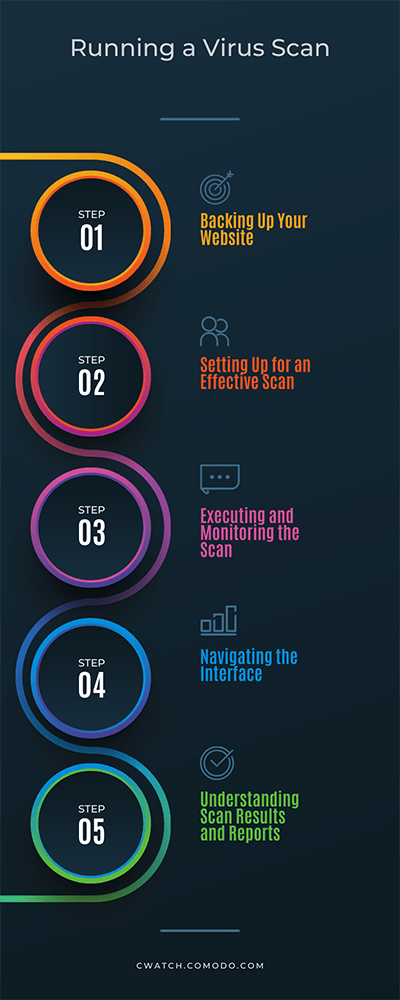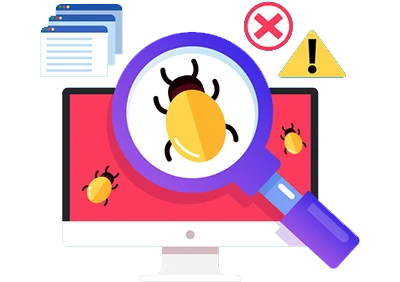Step-by-Step Process for Running a Virus Scan
Preparing Your Website for a Virus Scan
Before initiating a virus scan, it's crucial to prepare your website to ensure the process is both practical and safe. This preparation phase is divided into two primary steps: Backing up your website data and setting up for an effective scan.
- Backing Up Your Website Data: The first and foremost step is to back up your website data. This is a critical safeguard for your website's information if anything goes awry during the virus scan. Start by backing up all your website files, including HTML, CSS, JavaScript, and multimedia content. Pay attention to your databases, as they are often the most valuable part of your site. Use tools that automate the backup process, ensuring you have your site's most recent version stored safely. Keeping these backups on a separate server or cloud storage is advisable to avoid any potential threats that might affect your primary server.
- Setting Up for an Effective Scan: Once your data is securely backed up, the next step is setting up for the scan. Ensure your website runs on the latest version of all software, including the content management system (CMS), plugins, and themes. Outdated software can contain vulnerabilities that might be exploited during the scanning process. Also, make sure to turn off any content caching systems temporarily. Caching can sometimes mask malicious code, preventing the virus scanner from detecting it. Lastly, inform your web hosting provider about the upcoming scan, especially if you expect it to be resource-intensive. This prevents misunderstandings, as some hosting providers might mistake the scanning activity for an actual attack.
- Executing and Monitoring the Scan: With your website prepared, it's time to initiate the virus scanning process. This phase involves two critical steps: navigating the cwatch.comodo.com interface and understanding the scan results and reports.
- Navigating the Interface: cWatch offers an intuitive interface that makes running a virus scan straightforward. Begin by logging into your cWatch account. Once logged in, navigate to the 'Virus Scan' section. Here, you'll find options to configure your scan. You can choose a full scan, which checks every file and database on your website, or a custom scan, where you can specify particular areas or files to be checked. After configuring your scan settings, initiate the scan process. cWatch also allows you to schedule scans at regular intervals, ensuring ongoing protection for your site.

- Understanding Scan Results and Reports: After the scan is complete, it's essential to review the results and reports generated by cwatch.comodo.com carefully. The scan report will detail any malicious code, vulnerabilities, and potential security threats on your website. Pay close attention to any flagged items and review the recommended actions. Some issues require simple fixes, such as updating a plugin, while others are more complex and need a deeper investigation. Addressing these findings promptly is essential to ensure your website's security. Additionally, cwatch.comodo.com provides insights and analytics about the scan, which can be valuable for understanding the overall health of your website and planning future security strategies.
Why Choose cWatch?
Choosing the proper protection service is critical in the realm of website security. cWatch, developed by Comodo, is an exceptional choice for several compelling reasons. This detailed analysis highlights why cWatch should be your go-to solution for website security.
Robust Security Features
cWatch is not just an essential security tool; it's a comprehensive security suite designed to protect websites against many cyber threats. It offers a range of features like malware detection, automatic removal, and proactive threat prevention. One of its standout features is the Web Application Firewall (WAF), which safeguards your website from various online threats, including SQL injection, cross-site scripting, and DDoS attacks. The WAF is continually updated to defend against the latest threats, ensuring your website remains secure against evolving cyber risks.
24/7 Monitoring and Response
Cyber threats don't adhere to a 9-to-5 schedule; they can occur anytime. cWatch understands this and offers 24/7 monitoring of your website. This round-the-clock surveillance ensures that any suspicious activity is detected and addressed immediately, minimizing potential damage. In addition, cWatch's Cyber Security Operations Center (CSOC) is staffed with certified security analysts who provide continuous surveillance and swift response to security incidents, offering peace of mind that your website is always under watchful eyes.
User-Friendly Interface and Ease of Use
cWatch is designed with the user in mind. Its intuitive Interface makes it easy for website owners, even those with limited technical expertise, to navigate and utilize its features effectively. Setting up cWatch is straightforward, and its dashboard provides a clear, concise overview of your website's security status. This user-friendly approach allows website owners to manage their security easily without extensive technical knowledge.
Comprehensive Reporting and Analytics
Knowledge is power, especially when it comes to cybersecurity. cWatch offers comprehensive reporting and analytics, providing detailed insights into the security status of your website. These reports are not only helpful in understanding the types of threats your website faces but also for compliance purposes. For businesses that need to adhere to specific regulatory standards, cWatch's reports can be invaluable in demonstrating due diligence in cybersecurity practices.
Cost-Effectiveness and Scalability
cWatch offers a cost-effective solution for website security. It provides high-level security features at a price point accessible to businesses of all sizes. This affordability does not come at the expense of quality; cWatch delivers enterprise-grade security that can scale with your business. Whether you run a small blog or a large e-commerce platform, cWatch can adjust to your growing security needs.
Reputation and Reliability
Comodo, the creator of cWatch, is a well-known and respected name in the cybersecurity industry. This reputation for reliability and excellence is a testament to the quality of cWatch. Choosing cWatch means entrusting your website's security to a provider with a proven track record of protecting against cyber threats.
Customer Support and Resources
Finally, cWatch stands out for its excellent customer support. Users can access many resources, including a knowledgeable support team, comprehensive FAQs, and a user community. Whether you need technical assistance or want to learn more about best practices in website security, cWatch provides the resources to support you.Virus Scan FAQ
Answer: A virus scan on your website checks for malicious code, malware, and other security threats that could harm your website or compromise user data. It scans files, databases, and scripts to identify potential vulnerabilities and infections.
Answer: The frequency of virus scans depends on your website's nature and the traffic level it receives. Generally, it's advisable to perform a weekly scan for most websites. However, if your site processes sensitive information or experiences high traffic, more frequent scans - possibly daily - are recommended.
Answer: While a virus scan can be resource-intensive, most modern scanning tools, like those offered by cWatch, are designed to minimize any impact on website performance. It's best to schedule scans during off-peak hours to reduce any potential slowdown further.
Answer: If a threat is detected, it's crucial to address it immediately. Follow the specific instructions provided by your virus scanning tool. This may involve removing or quarantining the infected files and taking steps to patch vulnerabilities. In severe cases, consult with cybersecurity professionals for further assistance.
Answer: While virus scans are excellent for detecting threats and vulnerabilities, they do not typically fix them. However, many tools, including cWatch, provide recommendations or automated solutions for addressing some common issues. For complex vulnerabilities, manual intervention may be required.
Answer: Yes, backing up your website before performing a virus scan is highly recommended. This precaution ensures that you have a safe copy of your website if something goes wrong during the scan process.






